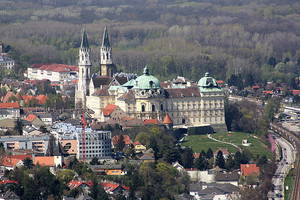Klosterneuburg

The town of Klosterneuburg, with today 26.000 inhabitants, is situated on the river Danube just north of Vienna, from which it is separated by the Kahlenberg and the Leopoldsberg hills. On the other side of the Danube lies its partner city Korneuburg.
Earliest proofs of settlement trace back to the Neolithic, constant settlement is believed to have begun in the middle of the 1st century AD, with the construction of a Roman camp for auxiliary troops in the province of Pannonia.
The oldest written reference to “Nivvenburc” (Neuburg) dates from 1108 and is to be found in the cartulary of the monastery of Klosterneuburg. As from 1113, Klosterneuburg was the residence of the Babenberger margrave Leopold III and his wife Agnes. In 1114 the foundation stone of the monastery church was set.
The Danube was both vital and a deathtrap for the settlement. A major part of the trading goods arrived by water, while frequent floodings pushed the settlers more and more inland on each side of the river. Thus Neuburg Klosterhalben (Klosterneuburg) and Neuburg Markthalben (Korneuburg) began to drift apart. In 1298 Albert I assigned a municipal law of its own to Neuburg Klosterhalben, which later became Klosterneuburg.
The Lower Town (today Stadtplatz and Martinsviertel) was repeatedly sacked and destroyed, while in the better protected Upper Town the population felt safer. In the Battle of Vienna in 1683, the town, though not very strong, was able to stand the Ottoman siege and support the rescue troops.
In 1805 and 1809 Klosterneuburg, as well as Vienna, was occupied by the French troops, even Napoleon himself was in Klosterneuburg Monastery on Dec. 20th, 1805.
Until the middle of the 19th century, Klosterneuburg was a remote small wine grower village, with a population of approximately 5000, in the 1930ies about 15000. During the Third Reich Klosterneuburg was incorporated into Groß-Wien.
Today Klosterneuburg is the third biggest city of Lower Austria and a cultural center with wide variety of offers. Apart from the splendiferous monastery of the Augustinian Canons, the Essl Museum (opened in 1999), with one of the biggest private contemporary art collections, attracts large numbers of visitors. The architect of the Essl Museum, Mr. Heinz Tesal, also designed the modern church of the Protestant community of the town, which due to its unusual architecture also is worth seeing.
Sources:
www.klosterneuburg.at ; http://de.wikipedia.org/wiki/Klosterneuburg
Image source:
http://commons.wikimedia.org/wiki/File:StiftKlosterneuburg_b.jpg?uselang=de





